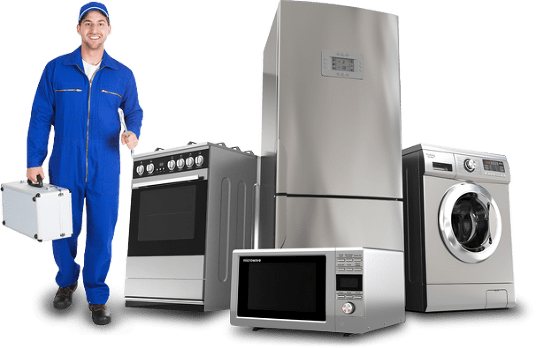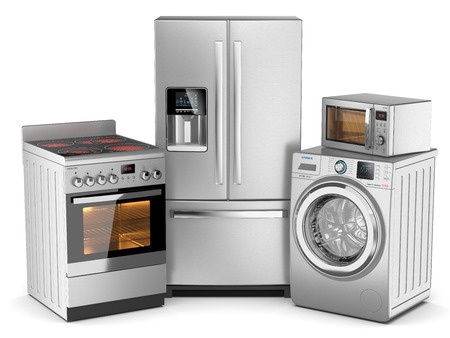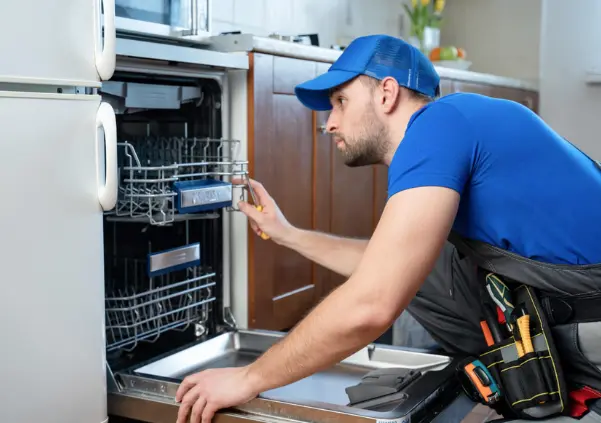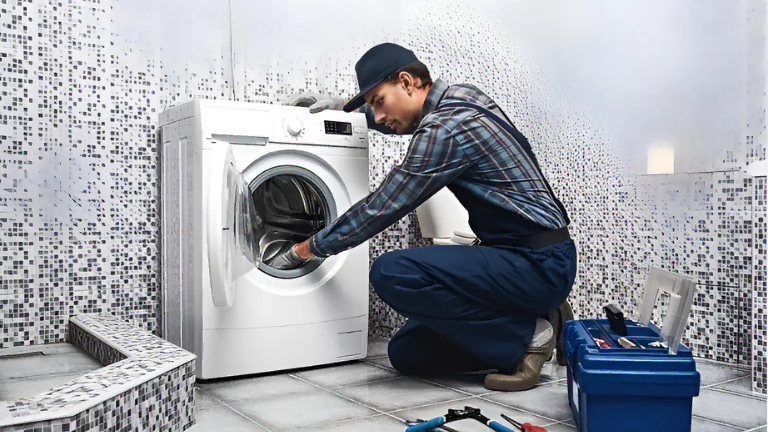Top 10 Common Appliance Problems and How to Fix Them

In modern households, appliances such as washing machines, ovens, dryers, and dishwashers play a pivotal role in keeping daily routines efficient. Over time, these devices experience common issues like dirty condenser coils, faulty heating elements, or clogged drain hoses—all of which can disrupt your life if left unaddressed. In this blog, we’ll identify and explore the Top 10 Common Appliance Problems and their solutions, ensuring your household appliances remain at optimal performance. By following our practical tips—and seeking help from professionals when needed—you’ll keep each device running smoothly for years to come.

Common Household Appliance problems
Home appliances enable us to maintain a comfortable, convenient lifestyle. Unfortunately, they can break down due to normal wear-and-tear, improper usage, or overlooked maintenance steps. Below are the six most frequent appliance issues that affect an array of models and brands.
1. Broken Heating Element
Often found in ovens, stoves, or dryers, a faulty heating element prevents the appliance from reaching its intended temperature. For a range or stove, you might experience uneven heating that leaves dishes undercooked or burnt at the edges. In a dryer, clothes remain damp or cold. Replacing the damaged coil or element typically resolves the issue, restoring consistent heat and letting your routine return to normal.
2. Clogged Drain Hose
A drain hose ensures surplus water flows out of your washing machine or dishwasher effectively after each cycle. Over time, items like food remnants, lint, or soap residue can obstruct this hose, causing water backups or subpar cleaning. Inspecting the drain hose for blockages—like lumps of grease or food particles—and rinsing it out can fix the problem and avoid potential flooding in your kitchen or laundry room.
3. Dirty Condenser Coils
Refrigerator or freezer coils, typically found underneath or behind the unit, regulate internal temperature by releasing heat. When these coils accumulate pet hair, dust, or cooking oils, they prevent the compressor from effectively cooling. This scenario often leads to higher energy use and a freezer or fridge that fails to maintain the correct temperature. A routine cleaning using a coil brush or vacuum can drastically improve overall performance.
4. Faulty Spray Arms
In a dishwasher, the spray arms rotate to distribute pressurized water. Food remains or minerals can obstruct the small jets, diminishing wash quality and leaving behind crusted plates or dishes dirty. Detaching these arms for a warm soapy water rinse or soaking them in a vinegar solution helps preserve their full water pressure output and ensures a pristine dish load every time.

5. Malfunctioning Thermostats
A faulty thermostat impairs your appliance’s capacity to regulate its temperature. Whether in an oven struggling to bake or a dryer failing to generate sufficient heat, addressing the thermostat quickly is essential to avoid prolonged undercooking or damp laundry. Testing and recalibration, or occasionally swapping the thermostat with a new one, is an easy fix for qualified technicians.
6. Defective Door Switches
Appliances like dishwashers, washing machines, and dryers incorporate a door or lid switch that halts operation when the device is opened. Should the switch break, the machine might not start, or it may halt mid-cycle, causing frustration. Replacing a faulty door switch is fairly straightforward yet crucial for safe operation.
The Importance of Timely Appliance problems Repairs
- Prevent Higher Costs
Putting off small repairs can lead to bigger failures requiring more extensive or expensive fixes. An ignored belt in a dryer or a minor water leak in a dishwasher can escalate into a motor meltdown or serious water damage. - Optimize Daily Life
Faulty appliances disrupt household tasks, from missing your family dinner because of a broken oven to skipping laundry day if your washer fails. Timely repairs keep your tasks on track, letting you maintain a normal day routine. - Extend Appliance Life
Swiftly resolving a malfunction often spares the machine’s other components from accelerated wear. By replacing a drain line or dirty condenser coils quickly, you help maximize the appliance’s overall life. - Ensure Safety
Appliances running at partial or improper power risk electrical or gas hazards, including leaks, shocks, or overheated circuits. Promptly addressing unusual or loud noises or visible damage reduces such dangers significantly.
Preventative Maintenance for Appliances
Regular Cleaning Practices
Using a mild detergent and warm water, wipe down surfaces, seals, and door gaskets monthly to avoid grease buildup or trapped food residue. This measure safeguards your appliance from odor, potential blockages, and inefficient performance.
Routine Inspections and Checks
Glancing over your power source, water inlet valve, or internal parts on a monthly or bi-monthly basis can highlight looming problems. For instance, noticing a frayed power cord on an oven or a seal that’s loosening helps you intervene before the device fully fails.
When to Seek Professional Help for appliance problems
While minor tasks—like cleaning a lint filter or unclogging a drain hose—are manageable at home, bigger, more technical issues demand a professional approach. Specifically, scenarios involving gas leaks, major electrical issues, or faulty mechanical parts (like a seized motor) are best left to trained appliance repair technicians with the correct tools and expertise.
How Can Toronto Refrigeration Help?
Toronto Refrigeration has committed to delivering exceptional quality and reliable service to clients in the GTA area for many years. Our professional staff handles everything from dishwasher repair or dryer repair to stove repair or freezer repair—covering a wide range of brand models. With an eye for detail and a passion for efficiency, we replace defective parts—like a drain pump in a dishwasher or a broken belt in your washing machine—while ensuring minimal disruption to your daily life. Our advanced maintenance services and emergency repair solutions help you save time, money, and stress, letting you enjoy peace of mind with every fix.
Top 10 Common Appliance Problems and How to Fix Them
Below is a breakdown of widely encountered common appliance issues—and the recommended actions to keep your devices operating at optimal performance:
- Oven Not Heating
- Cause: Faulty heating element or thermostat calibration.
- Fix: Inspect for visible breaks in the coil or test the fuses. If unsure, consult a professional.
- Dishwasher Not Draining
- Cause: Clogged drain hose or broken dishwasher water pump.
- Fix: Remove food scraps, check the hose for obstructions, and ensure the water is draining properly.
- Refrigerator Not Cooling
- Cause: Dirty condenser coils, faulty thermostat, or misaligned door seal.
- Fix: Brush away debris from the coils, confirm temperature settings, and examine the door’s seal for cracks.
- Dryer Not Spinning
- Cause: A snapped belt, worn drum rollers, or a jammed motor.
- Fix: A quick belt replacement or motor reset can restore the cycle. If heat remains absent, the heating elements or Thermal Fuse might be at fault.
- Washing Machine Leaks
- Cause: Faulty water inlet valve, damaged rubber seal, or compromised drain lines.
- Fix: Inspect for cracks in the seal, test for tight connections, or check the load capacity to avoid overflow.
- Microwave Not Heating
- Cause: A malfunctioning magnetron or miswired internal components.
- Fix: Replacing a magnetron is complicated—hire a professional to handle any electrical rework.
- Stove Burners Not Igniting
- Cause: Blocked burner ports, a faulty* ignition switch, or a compromised gas line.
- Fix: Gently clean burner openings, ensure no lumps block the path, and confirm the pilot flame or igniter clicks.
- Freezer Over-Frosting
- Cause: Frozen defrost drain or failing defrost timer leads to constant ice buildup.
- Fix: Manually defrost for 24 hours or consult a professional if the freezer’s defrost cycle remains dysfunctional.
- Venting / Exhaust Issues
- Cause: Overstuffed dryer or range hood with lint / debris, obstructing airflow.
- Fix: Clear the vent or check for lodged objects. Keep the lint filter clean and fans dust-free.
- Unpleasant Odors in Washer
- Cause: Trapped food or detergent residue, mold growth in the drum, or stagnant water in the drain hose.
- Fix: Run a hot cycle with cleaning agent, wipe inside with warm water and mild detergent, ensure the door is aired out to prevent mustiness.

Conclusion (90 words)
Household appliances problems—from dryers and stoves to refrigerators and washing machines—sustain everyday convenience. Delaying fixes on common issues such as a dirty condenser coils or a faulty igniter can spiral into costly repairs and bigger inconveniences. By practicing regular maintenance and promptly addressing unusual noises, water leaks, or misaligned temperature settings, you safeguard your home’s comfort and each machine’s life. If repairs surpass your expertise, a professional approach ensures a thorough solution. With consistent care and mindful checks, your appliances can serve your family for years to come.
You said:
Please add more keywords
ChatGPT
professional appliance repair services
Introduction
From washing your clothes to cooking meals, household appliances such as washing machines, ovens, and dishwashers play a vital role in daily life. Yet, over time, each device can face diverse common issues—ranging from a broken heating element in your stove to a clogged drain hose in your washer. In this blog, we’ll spotlight the Top 10 Common Appliance Problems and practical fixes. By pinpointing malfunctions early and applying prompt repair solutions, you can keep your appliances at optimal performance, extend their life, and spare yourself from stressful, costly repairs.
Common Household Appliance Issues
Even the best brands of appliances endure wear and tear. Understanding frequent malfunctions helps you address them quickly and preserve convenience:
Broken Heating Element
Found in stoves, dryers, or ovens, heating elements dictate your appliance’s ability to reach the correct temperature. A faulty heating element might exhibit uneven heat, extended cooking or drying times, and potential risk of undercooked meals or wet clothing. Inspect for visual breaks or scorching on the coil or contact a professional if uncertain.
Clogged Drain Hose
Whether it’s a washing machine or dishwasher, a drain hose channels water out after each cycle. Overloading these appliances or ignoring leftover food or lint can generate blockages, leading to partial drainage or minor floods around your machine’s base. Regular checks and clearing out food scraps or lint forestall such breakdowns.
Dirty Condenser Coils
For a fridge or freezer, heat expulsion relies on clean condenser coils. If coated in grease, dust, or pet hair, your refrigerator or freezer must overwork to keep contents cold, risking higher bills and potential spoiled food. A quick sweep with a coil brush every few months preserves consistent chill.
Faulty Spray Arms
In dishwashers, water jets passing through spray arms must remain unobstructed to rinse plates or cookware effectively. If you notice dishes not coming out clean, check for food particles or mineral buildup in the jets. A thorough rinse with warm water and a mild brush often eliminates blockages.
Malfunctioning Thermostats
Appliances like stoves, ovens, or dryers require precise temperature regulation. A faulty thermostat disrupts heating consistency, manifesting in partially cooked meals or damp laundry. Confirm your device’s temperature settings with an external thermometer or rely on professional testers, especially if you sense unusual results.
Defective Door Switches
A defective door or lid switch may abruptly stop a dishwasher, washer, or dryer mid-cycle, jeopardizing your workload. If your machine unexpectedly halts, test whether the latch is engaging. Swift replacement of a failing switch prevents repeated cycle stoppage and potential water spills.
The Importance of Timely appliance problems Repairs
Minor annoyances—like an oven’s lukewarm burners or a dishwasher’s extended cycles—often warn of underlying common appliance issues. Taking early action yields multiple advantages:
- Reducing Repair Costs
Quick detection of faulty parts saves you from bigger, more expensive breakdowns. Replacing a single motor or coil promptly negates the chance of further internal damage. - Maintaining Daily Life Flow
A broken fridge or inoperable washer disrupts meal prep or laundry routines. Timely solutions minimize frustration, keeping your food fresh and clothes clean. - Preventing Safety Hazards
Certain problems—like electrical issues, gas leaks, or water infiltration—pose threats if disregarded. Swift professional help ensures your home environment remains safe.
Preventative Maintenance for Appliances
Extending each appliance’s life and performance doesn’t require complicated measures—just consistent vigilance. Routine upkeep tackles hidden issues early:
Regular Cleaning Practices
Removing food residue from your dishwasher’s detergent dispenser, wiping away lint from your dryer’s lint filter, or clearing grease from stove surfaces are simple tasks but crucial for optimal function. This regular maintenance prevents clogs and buildup that escalate wear.
Routine Inspections and Checks
Monitor your fridge’s temperature, confirm your dishwasher’s water flow, or quickly test the stovetop burners for correct heat output. Spotting a malfunction before it worsens preserves each device’s reliability, reduces inconvenience, and saves money on bigger repairs.
When to Seek Professional Help
Occasionally, appliances exhibit strange noises, defective thermostat settings, or inadequate water supply, indicating a serious problem that basic fixes can’t solve. In such cases, arranging Professional Repair is imperative. For instance, a dryer struggling with lint buildup around the drive belt or a dishwasher producing odd clunks due to a dirty filter might require a professional technician. These skilled technicians have the know-how, experience, and tools to perform advanced diagnostic checks and solutions—reducing the risk of further damage. Addressing these concerns promptly ensures your appliances stay reliable and your household runs smoothly.
How Can Toronto Refrigeration Help?
At Toronto Refrigeration, we’ve devoted ourselves to upholding exceptional quality and reliable service in appliance problems repair across the GTA. We handle a wide range of tasks, from dishwasher repair or dryer repair to freezer repair, tackling everything from stove burners not igniting to clearing out clogged lines or dealing with water infiltration. Our professional team identifies each appliance’s root issue promptly, providing swift solutions that minimize daily disruptions. With a commitment to customer satisfaction and competitive or reasonable pricing, we consistently deliver the results that your household or business relies on for a functional and comfortable environment.
Top 10 Common Appliance Problems and How to Fix Them
Below we detail the ten most widespread household headaches, from defunct motors to persistent leaks:
- Oven Not Heating Thoroughly
- Cause: Possibly a faulty heating element or compromised thermostat.
- Solution: Inspect for cracks or discoloration on the coil. If you find none, your temperature sensor or control panel may need a professional’s attention.
- Dishwasher Not Draining
- Cause: A clogged drain hose, jammed drain pump, or blocked float.
- Solution: Clear lumps of food or grease, verify that your water can flow unimpeded, and consider an appliance repair if draining remains slow.
- Refrigerator Running Warm
- Cause: Dirty condenser coils, faulty temperature sensor, or brittle door seal.
- Solution: Use a coil brush to remove dust or check for tears in the gasket. If the fridge can’t maintain a stable internal temperature, consult a pro for likely fan or compressor checks.
- Dryer Not Spinning
- Cause: Possible snapped belt or a motor jam.
- Solution: After verifying the power supply, remove the dryer front panel to see if the belt is worn, ensuring you disconnect it from electricity first. If unsure, an advanced look by a professional helps you avoid shock hazards.
- Washing Machine Leaks
- Cause: Loose door seal, worn water inlet valve, or cracks in the drain system.
- Solution: Evaluate the rubber lip for tears and confirm no leaks at the connections. Check if the detergent dispenser is blocked, causing overflow.
- Range Burners Not Igniting
- Cause: Dirty burner ports, a gas line block, or an electrical connection problem.
- Solution: Gently clean the port with a pin, confirm normal gas flow or power if it’s an electric range. If it fails to light, the ignition switch may be at fault.
- Microwave Sparking
- Cause: Worn waveguide cover or stray bits of metal foil inside.
- Solution: Remove any aluminum or metal debris. If sparks persist, let a professional check for deeper mechanical or electrical issues.
- Food Disposal Not Working
- Cause: Blocked blades, foreign objects jamming, or a busted internal reset switch.
- Solution: Disconnect power, carefully remove debris using tongs or pliers. Press the device’s reset button if jam persists.
- Freezer Not Staying Cold
- Cause: Dirty condenser coils, restricted airflow, or a malfunctioning evaporator fan.
- Solution: Clean the coils, rearrange items that block cold air vents, or test for fan noise to confirm it’s operational.
- Washer Stuck Mid-Cycle
- Cause: A failing control panel, defective lid switch, or a glitch in the program.
- Solution: Test if the lid or door latch is engaging properly. If no luck, you might need an appliance problems repair approach to fix any electrical miscommunications.
Conclusion
Whether coping with a drain hose blockage in your dishwasher or a faulty thermostat in your oven, being aware of common issues ensures quick fixes and minimal disruption to your day. By performing periodic checks—like unclogging filters, wiping away grease, and maintaining consistent temperature settings—you save time and curb more serious problems. When mechanical or electrical troubles exceed your confidence or skill set, rely on professional appliance problems repair experts for a safe, reliable resolution. Proper care, timely repair, and proactive upkeep keep your entire household running smoothly.